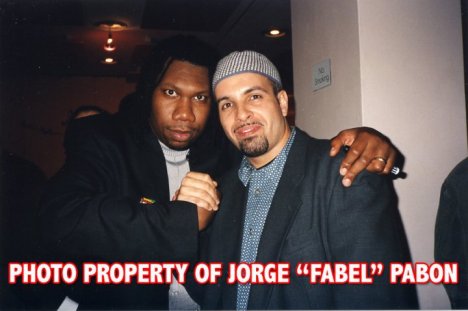
Karate Charlie & Bam Bam
The notorious Black Spades was once the largest and most feared gang in New York City. Hailing from the Bronx, the Spades had as their warlord, Hip Hop pioneer Afrika Bambaataa. They were the precursors to Hip Hop.. We caught up with many of the members including original leader Bam Bam who gave Bambaataa his name. We spoke with Hip Hop legend Popmaster Fabel who is finishing up a documentary on early gang culture called ‘The Apache line’. We also hear from Karate Charlie who was the President of the Ghetto Brothers which was another large street organization highlighted in Jeff Chang’s book ‘Cant Stop Wont Stop’..
https://www.youtube.com/watch?v=2nwsdYU4yKM
We talk with Hip Hop legend Popmaster Fabel who talks to us about the important role early gang culture played in bringing Hip Hop to life. We also talk about how pop culture is exploiting gang life and leading people astray. Fabel explained that early Hip Hop got people out of the gangs.. Today’s rap music gets people into them..
We hear an impassioned Bam Bam, original leader of the Black Spades speaking to young gang bangers in New York, Crips, Bloods, Latin Kings etc and explaining the direction they should really be taking.. powerful words..
https://www.youtube.com/watch?v=UGYTeRUWK5k

Popmaster Fabel
At the 40th Anniversary of the Black Spades we see Bam Bam, original leader of the Black Spades re-uniting and talking with Karate Charlie of the Ghetto brothers. They talk about how the two gangs merged together to stop the Hells Angels from coming into the Bronx.
We chop it up with Popmaster Fabel about his new documentary The Apache Line from gangs to Hip Hop.. We also talk to him about the current move to try and pit Black against Brown.. Fabel gives a history of why that happens and talks about how the gangs came together.
We also speak with Karate Charlie who is featured in Fabel’s documentary about the legacy of the Ghetto Brothers. He talks about how the Black Spades the Ghetto Brothers united and became a family. He also talked about how they protected the community against the police… Charlie also explains how he taught martial arts throughout the community and had Ghetto Brothers patrol the subway years before the Guardian Angels under Curtis Sliwa came into being..
https://www.youtube.com/watch?v=0ufPt8g617I

Charlie Rock Original Zulu King
We caught up with original B-Boy and Zulu Charlie Rock who hails from the 22cd division of the Black Spades up on Gun Hill road in the Bronx.. He talks about how the Black Spades evolved and became the Zulu Nation..He talks about Disco King Mario and the founding Spade chapters at Bronxdale Housing project which was known as Chuck City…
He also talks about how the early gangs were organized and became targets to corrupt police.. He talks about how three members, Wildman, Soulski and Meathead Ron were murdered by police. He noted that because the Black Spades were organized many of them were targeted by the police who tried to break them up and shrink their numbers…
Charlie Rock also talks about how New York was segregated and runs down all the racial unrest and white gangs the Black Spades and later Zulu Nation had to fight.. He talks about the Golden Guineas and the Ministers up in Parkchester.. He talks about the White Assassins and the White Angels..
Rock also explained how the police used to work in concert with some of these white gangs to try and defeat the Black Spades which was the largest gang in NY.. He talks about how the police hung him over a rooftop and threatened to kill him..



 Kool DJ Herc, originally from Jamaica, is credited with extending these breaks by using two turntables, a mixer and two of the same records. As DJs could re-cue these beats from one turntable to the other, finally, the dancers were able to enjoy more than just a few seconds of a break! Kool Herc also coined the terms “b-boy” and “b-girl” which stood for “break boys” and “break girls.” At one of Kool Herc’s jams, he might have addressed the dancers just before playing the break beats by saying, “B-Boys are you ready?! B-Girls are you ready?!” The tension started to mount and the air was thick with anticipation. The b-boys and b-girls knew this was their time to “go off!”
Kool DJ Herc, originally from Jamaica, is credited with extending these breaks by using two turntables, a mixer and two of the same records. As DJs could re-cue these beats from one turntable to the other, finally, the dancers were able to enjoy more than just a few seconds of a break! Kool Herc also coined the terms “b-boy” and “b-girl” which stood for “break boys” and “break girls.” At one of Kool Herc’s jams, he might have addressed the dancers just before playing the break beats by saying, “B-Boys are you ready?! B-Girls are you ready?!” The tension started to mount and the air was thick with anticipation. The b-boys and b-girls knew this was their time to “go off!” “Power moves” is a debatable term since it is questionable which movement requires more power: footwork and freezes or spins and gymnastics. One notable point introduced by B-Boy Ken Swift is that spins are fueled by momentum and balance which require less muscular strength than footwork and freezes. The laws of physics prove this to be true: spins require speed and speed creates momentum. The advent of “power moves” brought about a series of spins which became the main focus of the media and the younger generations of dancers. The true essence of the dance was slowly overshadowed by an over abundance of spins and acrobatics which didn’t necessarily follow a beat or rhythm. The pioneers didn’t separate the “power moves” from the rest of the dance form. They were B-Boys who simply accented their performance with incredible moves to the beat of the music.
“Power moves” is a debatable term since it is questionable which movement requires more power: footwork and freezes or spins and gymnastics. One notable point introduced by B-Boy Ken Swift is that spins are fueled by momentum and balance which require less muscular strength than footwork and freezes. The laws of physics prove this to be true: spins require speed and speed creates momentum. The advent of “power moves” brought about a series of spins which became the main focus of the media and the younger generations of dancers. The true essence of the dance was slowly overshadowed by an over abundance of spins and acrobatics which didn’t necessarily follow a beat or rhythm. The pioneers didn’t separate the “power moves” from the rest of the dance form. They were B-Boys who simply accented their performance with incredible moves to the beat of the music. In Los Angeles, California, Don Campbell, also known as Don Cambellock, originated the dance form “locking.” Trying to imitate a local dance called the “funky chicken,” Don Campbell added an effect of locking of the joints of his arms and body which became known as his signature dance. He then formed a group named “The Lockers,” who all eventually shared in the development of this dance. The steps and moves created by these pioneers were named and cataloged. Some of these include: the lock,points, skeeters, scooby doos, stop n’go,which-away and the fancies. Certain members of The Lockers” incorporated flips, tucks, dives and other aerial moves reminiscent of the legendary Nicholas Brothers. The main structure of the dance combined sharp, linear limb extensions and elastic-like movement.
In Los Angeles, California, Don Campbell, also known as Don Cambellock, originated the dance form “locking.” Trying to imitate a local dance called the “funky chicken,” Don Campbell added an effect of locking of the joints of his arms and body which became known as his signature dance. He then formed a group named “The Lockers,” who all eventually shared in the development of this dance. The steps and moves created by these pioneers were named and cataloged. Some of these include: the lock,points, skeeters, scooby doos, stop n’go,which-away and the fancies. Certain members of The Lockers” incorporated flips, tucks, dives and other aerial moves reminiscent of the legendary Nicholas Brothers. The main structure of the dance combined sharp, linear limb extensions and elastic-like movement. In 1976, The Electronic Boogaloo Lockerswas formed in Fresno, California by Sam “Boogaloo Sam” Soloman, Nate “Slide” Johnson and Joe “Slim” Thomas. Since the group’s inception, Sam has continued to recruit and help each member master his individual form. Some of Sam’s early inspirations were Chubby Checker‘s “Twist;” a James Brown dance called “the Popcorn;” “the Jerk;” cartoon animation and the idiosyncrasies of everyday people. From these many influences, Sam combined incredible steps and moves conceiving a dance form which he named “Boogaloo.” This form includes isolated sharp angles, hip rotations and the use of every part of the body. Sam’s brother, Timothy “Popin’ Pete” Soloman, described Boogaloo as a dance which was done by moving the body continuously in different directions.
In 1976, The Electronic Boogaloo Lockerswas formed in Fresno, California by Sam “Boogaloo Sam” Soloman, Nate “Slide” Johnson and Joe “Slim” Thomas. Since the group’s inception, Sam has continued to recruit and help each member master his individual form. Some of Sam’s early inspirations were Chubby Checker‘s “Twist;” a James Brown dance called “the Popcorn;” “the Jerk;” cartoon animation and the idiosyncrasies of everyday people. From these many influences, Sam combined incredible steps and moves conceiving a dance form which he named “Boogaloo.” This form includes isolated sharp angles, hip rotations and the use of every part of the body. Sam’s brother, Timothy “Popin’ Pete” Soloman, described Boogaloo as a dance which was done by moving the body continuously in different directions.








